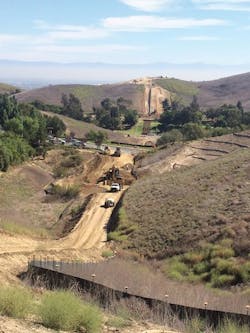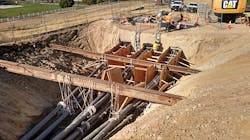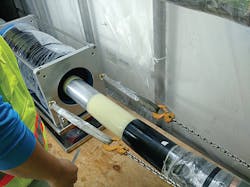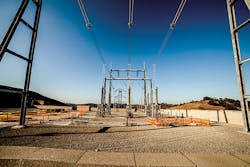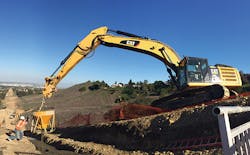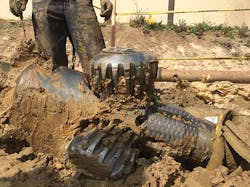SCE Puts 500-kV Underground
Undergrounding cross-linked polyethylene (XLPE) transmission cables has long been one of the routing alternatives utilities investigate when siting new high-voltage transmission lines for regulatory approval. However, cost and feasibility constraints have tended to override the benefits of undergrounding on these types of projects within the U.S. — until now.
The Southern California Edison (SCE) Tehachapi Renewable Transmission Project (TRTP) was approved as an overhead transmission line project by the California Public Utilities Commission (CPUC) in 2009 to deliver electricity generated at new wind farms in eastern Kern County to the Los Angeles Basin, more than 90 miles (145 km) away. Completion of the project would enable SCE to deliver up to 4500 MW of wind and other renewable energy — enough to power 3 million homes in Southern California.
During construction of an overhead segment of line between SCE’s Mira Loma and Vincent substations, a petition for modification was filed with the CPUC in October 2011 by the City of Chino Hills. A 220-kV overhead line historically ran through the center of town within an existing SCE easement that would be upgraded to 500-kV structures. Because this upgrade resulted in structures viewed as substantially larger than what currently existed, community organizers waged a campaign to have them replaced with 3.7 miles (6 km) of underground facilities.
Why Underground?
In 2013, the CPUC upheld the city’s petition and ordered SCE to remove the partially constructed 500-kV overhead line and replace it with underground facilities. Burying high-voltage lines underground may seem like an obvious solution, particularly in communities concerned about the impact 200-ft (61-m) transmission structures may have on the local landscape. However, the new underground alignment also contained a variety of drawbacks, from the greater ground-disturbing activities involved in construction to the long-term maintenance consideration and restrictions on land use. The greatest drawback was that SCE had little to no prior history in the development and operation of a hybrid overhead-to-underground 500-kV transmission line. SCE tackled this challenge methodically with some of the best minds in the industry.
Underground Facilities
The new underground alignment called for the transmission line to be installed along a 150-ft (46-m) right-of-way within densely populated regions of Chino and Chino Hills. It crossed two major thoroughfares, several minor roadways, a shopping center, two flood-control channels and two golf course fairways. In addition, one-third of the new alignment traversed steep, hilly terrain with an average grade of 15%. In some locations, the slopes were as steep as 35%.
TRTP began with the demolition of the already constructed 500-kV overhead infrastructure, including 16 double-circuit poles and towers as well as 27 foundations. The project then moved into the civil construction phase, which developed pads for the splice and restraint vault installations, the concrete-encased duct bank and access roads. The civil construction scope also included the development of two 3-acre (1.2-hectare) transition station pads, one of which would be constructed into the side of the rolling hills on the west end of the underground line.
While the installation included just a single circuit of two cables per phase, the infrastructure was designed and constructed to accommodate a future third cable per phase. Aligning the project within the right-of-way, engineering also made room for adding a second circuit in the future.
In all, TRTP involved the installation of 16,000 ft (4877 km) of duct bank, two 3-acre overhead-to-underground transition stations, 42 64-ft (19.5-m)-long splice vaults, 18 24-ft (7.3-m)-long restraint vaults and 32 telecommunications/partial-discharge acquisition vaults. In two locations along the route, horizontal directional drilling (HDD) was used to complete nine 36-inch (91-cm)-diameter bores ranging from 800 ft to 2100 ft (244 m to 640 m) in length.
Because of the critical nature of any extra-high-voltage transmission facility within an electrical grid, the infrastructure for this project was designed so the health of each cable phase and its accessories could be monitored in real time during operation. Distributed temperature-sensing and partial-discharge monitoring systems were installed so SCE engineers could track cable performance in real time.
A total of 72 cable pulls, 66 splice joints and 12 terminations were required to install the cable as well as the associated partial-discharge monitoring and distributed temperature-sensing systems. A set of shunt reactors were also installed at SCE’s Mira Loma substation to compensate for the high capacitance of the underground line.
First of Its Kind
TRTP is the first North American installation of 500-kV XLPE transmission line and the world’s first installation of a 500-kV transmission line in duct structures along steep terrain. While the basic principles of installing XLPE cable within duct systems is not new, the project team had no such installations from which to draw in the United States. In fact, at the time of this installation, American cable standards only addressed cable installations up to 345 kV. In addition, only four 500-kV XLPE transmission cable installations at this voltage had been completed worldwide at the time. They were primarily installed in tunnels or direct-buried systems.
As the first transmission line to be installed in duct structures at this voltage class, this project was subject to intense visibility and scrutiny from design through construction. The engineers understood the margin of error decreases as electrical stress limits on cable insulation is pushed. Thus, engineers paid close attention to questioning and reevaluating every aspect of the project’s cable system details and installation.
Transition Stations
Because the underground section of the line would be built in an existing overhead right-of-way, transition stations were needed to tie the overhead conductors needed to the underground cables. SCE has a great deal of experience in engineering traditional underground cable riser poles. But it was evident early on that a traditional riser pole design would not be feasible for 500 kV.
The two transition stations, each with identical equipment, were unique in that the west transition station needed to be built in steep hilly terrain while the east transition station was situated in a dense commercial zone. The layout of the stations had to incorporate space for two circuits, three cables per phase, a control room for metering and the ability to operate each set of cables independently.
Steep Terrain
To limit construction access and cable installation concerns, typical underground alignments tend to follow existing roadways as much as possible. By following a primarily off-road alignment with steep conditions at times, TRTP presented unusual obstacles to underground transmission contractors and cable installers.
Special cable restraint vaults were installed to manage cable movement and associated forces resulting from the steep grades. With 24-ft lengths, these vaults were comparable in length to typical underground transmission splice vaults. However, these installations were located along the steepest portions of the underground alignment, creating both construction access and delivery challenges. For example, access to the project site was restricted during and after rain events.
The project also required specialized means and methods for trench and concrete-encased duct bank installation on steep slopes. Special consideration was necessary for vault and cable deliveries as well as installation along steep-terrain access roads.
Horizontal Directional Drilling
The use of horizontal directional drilling (HDD) to install conduits beneath two flood-control channel segments posed particular challenges. While one 800-ft HDD segment, which required three separate bores, was straightforward, the other segment involved a compound curve to cross under a hillside and clear the bottom of a flood-control channel. Six independent bores — three for the first circuit and three for a potential future circuit — were required along an approximately 2100-ft stretch to navigate an inflection point within the 150-ft right-of-way.
Because of the complexities and potential impacts of borings that crossed a major jurisdictional water feature within a residential neighborhood, the construction team took several precautions. A frac-out (the release of drilling fluids into the surface environment) response plan was pre-established with regulatory agencies to enable more timely restarts if frac-outs occurred. Because of the proximity to residential neighborhoods, temporary sound walls were also installed to minimize local disturbance. Up to three drill rigs operated at any given time within this segment.
Special Routing
Almost every underground construction effort encounters its share of routing issues to address, and TRTP was no exception. High water tables required mitigating design and construction considerations for excavation of large vaults and deeper portions of the duct bank. A shallow stream crossing required temporary diversion in compliance with regulatory conditions of approval.
In addition to the various utilities crossed, the duct bank installation was especially difficult with the crossing of an 8-ft (2.4-m)-tall by 14-ft (4.3-m)-wide box culvert for storm water within a major thoroughfare immediately adjacent to a steep hillside alignment of the duct bank. With the underground duct bank terminating into a large, open power-cable trench — with inside dimensions of 12 ft (3.7 m) deep by 6 ft (1.8 m) wide — at each transition station with a 90-degree horizontal bend in the alignment, special cable pulling considerations were required to position the cable for termination assembly.
Environmental Constraints
Constant coordination and resequencing of work was necessary to navigate environmental constraints created by the project’s proximity to nesting birds. Likewise, work schedules were limited to accommodate seasonally restricted habitats of sensitive species.
Similarly, the location of some portions of the project within critical fire-protection sites in California required an occasional shutdown of work activities during red-flag warning events. The National Weather Service issues red-flag warnings when weather conditions become conducive to rapid or dramatic increases in wildfire activity.
Residential Population
Given its location within heavily residential, suburban communities, it required a significant coordination and public outreach effort to ensure not only the project’s success, but also the safety of construction crews and personnel as well as residents during construction. As with other segments of TRTP, a dedicated toll-free number was established for residents to voice complaints or concerns directly to the project team.
Feasibility Proven
The 500-kV underground cables and associated accessories — including the partial-discharge and distributed temperature-sensing monitoring equipment — were successfully commissioned in October 2016, approximately three years after the CPUC order to underground the line.
While costs for underground transmission will always be significant, the 500-kV TRTP sets a new standard in transmission line planning in the U.S., providing utilities with another proven routing alternative when siting future 500-kV transmission lines.
Acknowledgements
Although there was an endless number of people who contributed to the success of this project, the authors would like to acknowledge the following individuals for their support: Hunly Chy, lead cable engineer for SCE; Noe Bargas and Javier Izaguirre, lead civil engineers for SCE; Jennifer Wolf, project manager for SCE; Larry Winston, construction manager for SCE; Pete Hlapcich, principal engineering manager for SCE; Travis McKinney, program construction manager for Burns & McDonnell; Jon Busby, field engineering support for Burns & McDonnell; Shaun Fullmer, quality assurance/quality control manager for Burns & McDonnell; Tim Wynia, lead civil inspector for Burns & McDonnell; Teun Valstar, lead cable inspector for Burns & McDonnell; Bill Lawrence, inspector for Burns & McDonnell; Forest Rong, lead cable engineer for Black & Veatch; and Ian D. Grant, lead civil engineer for Black & Veatch.
Special thanks also goes to the construction contractors — PAR Electrical Contractors, Professional Electrical Services and ASB Electric, LLC — as well as the SCE construction crews. Finally, thanks to the cable manufacturing and installation team of Taihan Electric Wire, DAEWOO International Corp. (now POSCO DAEWOO) and New River Electrical Corp.
Jim Sheftal was the senior project manager who spearheaded the underground project team for Southern California Edison. Sheftal spent time in the substation construction group prior to leading the TRTP team. He has more than 30 years of construction industry experience, encompassing all facets of utility project planning and execution. Sheftal is now vice president of construction for Power Grade Inc., a California-based utility contractor.
Roman Vazquez works for Southern California Edison and is the principal project engineering lead on the Tehachapi Renewable Transmission Project. Before leading the TRTP team, Vazquez was the manager of SCE’s transmission engineering group; he has been with SCE since 1999. He holds a BSCE degree from California State University, Los Angeles, and is a registered professional engineer in California.
Charles “Chuck” Eck is a project manager in the T&D group at Burns & McDonnell who served as the project/construction manager for the underground portion of the Tehachapi Renewable Transmission Project. Eck has more than 25 years of experience in the power industry, with extensive experience in the engineering, construction and management of large-scale transmission and substation projects. He holds a BSEE degree from Worcester Polytechnic Institute and is a registered professional engineer in California.
BriAnna Chavez works in the transmission division of the T&D group at Burns & McDonnell. She joined the company after graduating with a BSCE degree from the University of Missouri. Her experience includes supporting field engineering duties and assisting with project management for large-scale transmission projects, specifically underground systems from 115 kV to 500 kV.

